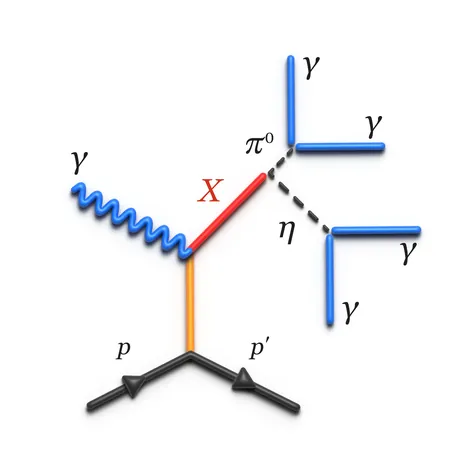
Exciting Breakthrough in Particle Physics: The Hunt for Hybrid Mesons is On!
2025-07-18
Author: Li
Discovering the Secrets of the Universe
In an intriguing twist of particle physics, a humble particle is paving the way to uncover subatomic mysteries. Mesons, like protons and neutrons, are formed from quarks bound by the strong nuclear force. However, their fleeting nature and unique characteristics hold the key to unlocking new insights into atomic structures and the very fabric of the universe.
Meet the Game-Changer: the a2 Meson
Enter the a2 meson—a lightweight assembly of quarks produced in groundbreaking experiments at the U.S. Department of Energy's Thomas Jefferson National Accelerator Facility. In a groundbreaking study published in *Physical Review C*, scientists have measured the a2 meson’s production probability when a polarized photon beam collides with a proton target for the first time.
Racing Toward the pi1 Meson
This pivotal measurement marks a significant step in the quest for the elusive pi1 meson, the lightest spin-exotic meson. As researchers aim to chart the mass spectrum of hybrid systems, this finding opens avenues for future discoveries that could reshape our understanding across nuclear power, medicine, and materials engineering.
Innovative Techniques Take Center Stage
According to Malte Albrecht, a Jefferson Lab physicist involved in the Gluonic Excitations Experiment (GlueX), this measurement isn't just notable on its own—it's a vital milestone on their roadmap towards researching exotic particles. "We took a well-understood particle and explored a fresh quantity using advanced techniques essential for studying hybrids," Albrecht explained.
The Driving Force Behind Hybrid Mesons
Gluons are the fundamental particles that wield the strong nuclear force, acting as the 'glue' that binds quarks into complex structures like mesons. The GlueX Collaboration, an international team investigating these fascinating phenomena, leverages the Continuous Electron Beam Accelerator Facility (CEBAF) to produce photons vital for their experiments.
How GlueX Peers into the "Black Box" of Particle Creation
Using innovative technology, GlueX transforms CEBAF's electrons into a stream of linearly polarized photons aimed at their atomic target. Specialized detectors analyze the resulting collisions, enabling scientists to dissect the enigmatic process of particle production. Lawrence Ng, a postdoctoral researcher at Jefferson Lab, elaborated, "The polarization of these photons offers us crucial insights into meson production dynamics."
The Quirky Cousin: pi1 Meson
The pi1 meson is like the a2’s eccentric sibling—similar in quark makeup but with distinct properties. Both exist within similar energy ranges and display a unique quark content that includes the 'up' and 'down' flavors. Yet, the pi1's gluons exhibit peculiar behaviors, making it harder to study experimentally.
A Standard Candle for Particle Physics
The a2 meson is dubbed the "standard candle" in the search for the pi1 meson, borrowing the term from astronomy, where it refers to an object with a known brightness serving as a reference point. To isolate the a2 among other particles generated during experiments, GlueX employs sophisticated partial-wave analysis to filter out extraneous data.
What’s Next for Research?
With this groundbreaking measurement now confirmed, the GlueX team is ready to pursue the pi1 meson further and even explore previously unseen hybrid states. Albrecht asserts, "Our achievement in using partial-wave analysis not only validates our method but sets the stage for uncovering exotic particles that may provide deeper insights into the universe’s fundamental rules."


 Brasil (PT)
Brasil (PT)
 Canada (EN)
Canada (EN)
 Chile (ES)
Chile (ES)
 Česko (CS)
Česko (CS)
 대한민국 (KO)
대한민국 (KO)
 España (ES)
España (ES)
 France (FR)
France (FR)
 Hong Kong (EN)
Hong Kong (EN)
 Italia (IT)
Italia (IT)
 日本 (JA)
日本 (JA)
 Magyarország (HU)
Magyarország (HU)
 Norge (NO)
Norge (NO)
 Polska (PL)
Polska (PL)
 Schweiz (DE)
Schweiz (DE)
 Singapore (EN)
Singapore (EN)
 Sverige (SV)
Sverige (SV)
 Suomi (FI)
Suomi (FI)
 Türkiye (TR)
Türkiye (TR)
 الإمارات العربية المتحدة (AR)
الإمارات العربية المتحدة (AR)